Join Honoree Bombardier, to learn how they rely on state-of-the-art technology and support from Hexagon to face their toughest challenges.
BK: Welcome to HxGN Radio. My name is Brian. Joining us today is Phuong Thanh Tran, supervisor of Quality Supplier Compliance and GD&T Measurements from Bombardier; as well as Gordon McClean, Principal Quality Engineer from Bombardier as well. They’re here to discuss how Hexagon technology supports innovation at Bombardier. Thanh and Gordon, thank you much for joining us today. Appreciate it.
PT: Thank you.
GM: Thank you for having us. It’s a pleasure to be here.
BK: Absolutely. Well, it’s great to have you. So, we want to know a little bit about Bombardier, what you do, and then we’ll get into some specifics.
GM: Okay. Bombardier’s a plane maker, and we’re based in Montreal. We work on the 7500 program, which is a private jet and best in class; highest luxury; very, very nice product.
PT: Yeah. So, basically, it’s a brand-new aircraft. It’s never been done before. New technologies. You have four-cabin living space. It can fit 19 people; 7,700 nautical range, so we’re talking about 9,000-mile flight.
BK: Which is impressive.
PT: Impressive. Basically, we’re both part of the measurement team at Bombardier. We operate the laser tracker; we analyze data; we measure parts at suppliers and everywhere around the world.
BK: Excellent. What are the biggest challenges that are facing your industry right now?
GM: With any industry, it’s cost and the quality of product that you are supplying. Customer expectations, because when they’re buying private jets, they have high expectations, which is always increasing. And logistics — we have suppliers all over the world, so getting the parts on time to where you need to join them together. These are the main challenges, I think.
PT: It’s having the quality first for our product. That’s really important for us. To satisfy our customers, we need to understand all their needs and how the market’s going, so we have to come with something innovative, something new on the market and in the industry that will satisfy the most people possible.
BK: Sure. And you’re obviously doing something that is new and sounds like really not been done before entirely.
PT: Actually, there’s so many innovations in there. We’re taking about new seat structure, new fly-by-wire systems, avionics, everything is really brand new, new designs, more-flexible wings. The aircraft is a whole new level of business aircraft, yes.
GM: And it’s the options that are available as well. So many different options that weren’t available before, and that gives challenges to us because you have so many different options available that you have to manage them and manage how they’re all going to fit together.
BK: That leads me to my next question which is, how is technology offering a solution, but then, also, how is it making things a little more difficult?
GM: Well, for us, it’s making things a lot easier. We have a team at Bombardier, a dimensional management team, and these guys look at all of our products that are coming in. They work out how much tolerance we have for each product, make sure all the interfaces come together with the least amount of re-work so that we can install everything quickly and we don’t have any surprises at the end of the line. They look at that first of all. Then, our measurement team comes in, and we are in charge of making sure that everything comes in in-tolerance. We go around to all the suppliers around the world. We show them how they should measure, we show them what methods to use, and then we take their measurements, and we do virtual analysis on everything that’s made so we have a picture of how it’s all going to come together in the final aircraft.
BK: That’s cool. When they’re getting this, though, how are you helping the customers to adopt that technology so they know how to use it, utilize it to the best possible ability?
GM: We will go there. We will specify what sort of equipment that we would advise they use. Say it’s a laser tracker, we’ll show them what are the key characteristics, what we need to know, what are the interfaces. We teach them how to measure with the laser tracker and how we create the report systems for them. They, then, send us the report, and we have the reports coming from all over the world. We look at the data and see how that’s all going to merge together, how that’s going to fit. If there’s something that’s outside of tolerance, then we initiate a re-work before the parts ever come to us so that when we get it to the aircraft, everything just fits in without having to re-work on-site.
PT: One of the big challenges is to have all the suppliers all around the world speaking the same language of the same standard. In terms of measurements, we want to have everyone aligned together on the same page. That’s one of the main challenges. And because we set our quality standards pretty high on this product, everything has to fit well. We need a level precision in our measurements and our data.
BK: Nice. Nice. So is it hard to keep up with the new tech that’s coming out? Sounds like you’re cutting edge, but just wondering how hard it is.
GM: I wouldn’t say that it’s hard to keep up. And it’s nice when something new comes out and you can evolve. There are certain things that you’re constricted with, and the new technology comes out and it makes that just a little bit easier. The challenge, then, is to go to each of your suppliers and help them to incorporate that into their product line.
BK: Good. So, you’re able to keep on top of it.
GM: Yeah, pretty much.
PT: All the time.
BK: Tell me a little about how your team identifies ways to be innovative. I mean, like you’ve even said, you’re already being innovative with this new aircraft, but give us some examples as well as how you’re being innovative and how you’re utilizing team dynamics and keeping them involved as well.
PT: For me, since I’m the supervisor, I want to make sure that all my team comes with the right mentality. The first thing is your attitude. In order to innovate something, you need to have an open mind. So every day you walk into work, with an open mind. You go there. You share your ideas. I mean, there’s no right or wrong ideas for us, just brainstorm ideas. We have meetings together. Work but at the same time have fun together, and that’s how ideas come, usually. When you feel good at work, new ideas will come.
GM: And it’s sharing. Again, with our suppliers, we are going there, we’re learning things from them, they’re teaching us things, and then we bring that back to our team. We see how we can do things better from our experience, like so many different suppliers. We also have support. We have suppliers in China, Morocco, all over the place. And if we are stuck on something, we can call some of the guys at Hexagon, and they’ve given us really good support.
BK: Good. It sounds like you have great two-way communication, you’re getting feedback, you’re implementing it, and you’re empowering your team and your suppliers, too, which is great.
GM: That’s the key thing is the suppliers. Empowering them and showing them that when we go in there, at first—and it’s new technology—they can be a little bit hesitant because they’re used to their own processes. But once we go there and show them the benefits and show them what they can do to improve the processes, based on the results, they end up usually incorporating it into all of their other programs as well. It’s a win-win.
BK: Yeah, sounds like it. That’s great. So now, you mentioned that you can call Hexagon anytime you have questions. How has Hexagon technology supported your innovation efforts?
GM: Well, like I said before, I used to work in Belfast, and we had 16 laser trackers there. We had and different equipment. So whilst I was there in Belfast, we had a lot of suppliers all over the world, and I would be called, maybe on a Tuesday, I would be called, “Okay, tomorrow you need to go to Morocco to measure…” whatever. I would call a rep in Morocco to see if we could get a laser tracker, then we would go there. We would be confident that you’re going to get the precision from the tool, and that it’s going to work the first time you’re going to set it up. It’s that confidence that you can have the support and you have the right tool for the job.
PT: Yeah. And Hexagon tools are widely used in our place for our new projects, measuring where the manufacturing line is at, if our parts are right or wrong. We’re basically implementing a lot of Hexagon technologies into our manufacturing line and daily activities, yes.
BK: Good to hear. All right, so tell us what innovation means to you, Bombardier, and also just how you’re moving forward with your customers.
PT: Well, on a personal level, innovation for me, that’s the key to the future. I really see it as, when innovating something, that’s where you bring in new ideas and where you take your product or your ideas to the next level. So that’s how you go into territory that you’ve never been before. So the way I see innovation, because I, myself have a master’s degree in innovation management and engineering, so what I see about innovation is you can have a product, you can go the same way for 150 years like this, and it can work. But with innovation, you can automate things. You can make things simpler, more efficient, better quality. You can adapt to the real—today’s world, you know.
GM: I agree. So, a lot of the conventional management and things like that is theoretical, but with innovation, it’s more of a pragmatic approach, where you see in real terms what is actually achievable, and you streamline your process to suit what you actually have instead of what the manufacturing tolerance is. You innovate with the tools that you have to improve your processes and move forward because otherwise, you just stagnate.
BK: Yeah. That’s very true. Well, very exciting and good to hear about everything that’s going on. And congratulations on the success that you have, and I’m glad you continue to innovate in creative ways, so thank you very much. Thanh, Gordon, appreciate your time today.
PT: Thank you very much.
GM: Thank you.
BK: And for more information, you can go over to bombardier.com. And, of course, to learn even more and listen to additional episodes, head over to hxgnspotight.com, and thank you very much for joining us here on HxGN Radio.
















